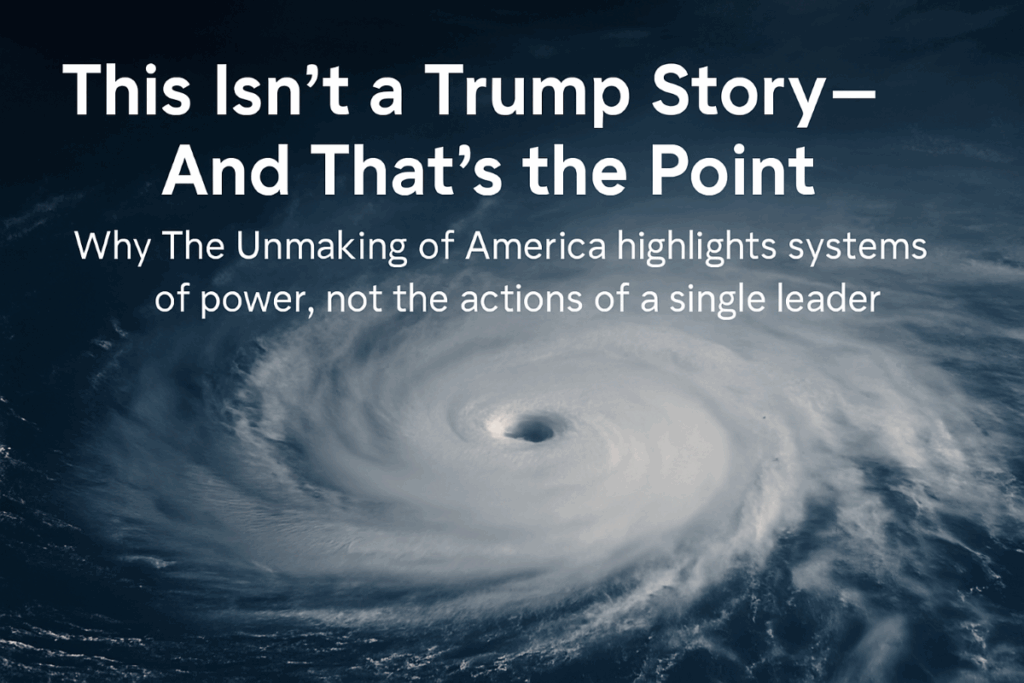One of the first questions readers might ask about The Unmaking of America is: Why isn’t this a Trump story?
It’s a fair question. Donald Trump dominates American news cycles—usually for the wrong reasons. His name, persona, and legacy hang over modern political discourse like a shadow. For many people, there’s no story of national breakdown without him. So why isn’t he central to mine?
Because this isn’t a Trump story. And that’s the point.
This Series Isn’t About a Man. It’s About a Machine.
This isn’t a Trump story because reducing systemic collapse to one name obscures the deeper, institutional corruption that drives it.
From the start, I chose to write a series about systems, not individuals. The Fall of America trilogy explores institutional collapse, legal erosion, and the weaponization of neglect. Those forces were in motion long before Trump stepped onto the political stage—and they’ll be here long after he’s gone.
Trump didn’t invent voter suppression. He didn’t create executive overreach, judicial capture, or deregulated capitalism. He simply understood how to exploit what was already broken. That distinction matters.
Focusing on him as a character would narrow the lens. I wanted readers to feel the weight of a political machine that has failed the public at every level. That machine is the real threat—not one man.
Why Trump Doesn’t Appear
Some readers may expect a Trump story by default. But the narrative here is designed to resist that expectation and shift the spotlight back to the machine.
In The Unmaking of America, Trump is part of the past. He is occasionally referenced, but never featured. He does not appear on the page, and he doesn’t speak. This was a conscious narrative decision.
First, there’s the issue of distortion. When you put Trump on the page, the story risks becoming an impersonation. Readers focus on accuracy, tone, mannerisms. The gravity of the narrative shifts. That distraction weakens the story I want to tell.
Second, Trump’s presence would give him too much power. He already dominates the national imagination. I wasn’t interested in feeding that further.
This isn’t a book about the man. It’s a book about the infrastructure that made him possible—and that will empower whoever comes next.
A Real-World Parallel: The Weather Cuts
If you want to understand the kind of slow collapse I’m writing about, look no further than this month’s news. The Trump administration has ordered the Pentagon to cut access to satellite microwave data used in hurricane forecasting. The decision will take effect during the heart of the 2025 storm season.
According to The Washington Post, this data is essential to tracking storm intensification overnight. Forecasters say its removal could set hurricane prediction “back by decades.” The Associated Press quotes experts warning that people in hurricane zones will have less time to prepare and fewer reliable tools to rely on.
This kind of decision doesn’t generate outrage because it’s technical. But it has real consequences. That’s what The Unmaking of America is about: the slow degradation of public services, scientific infrastructure, and government protections. This is what happens when power is treated as a tool for vengeance or personal branding instead of public service.
The Real Danger Isn’t a Trump Story. It’s What Survives Him.
A truly dangerous system doesn’t need a single strongman. It needs enablers. It needs silence. It needs people willing to look the other way while safeguards are dismantled piece by piece.
The story I’m telling is about that silence. About the normalization of dysfunction. About people like Trina and Tammy, or Nathan and Maria—who must navigate a world where the system no longer works but still pretends to.
If this were a Trump story, the answer might be to remove him. But this isn’t that simple. The danger isn’t in the name. It’s in the design.
Why It Matters
A focus on Trump gives readers a false sense of containment. If he is the problem, then the problem feels solvable. But what if the problem is deeper than that? What if the collapse is procedural, financial, cultural?
That’s the world of The Unmaking of America. Institutions haven’t disappeared—but they’ve been hollowed out. Laws still exist—but they’re enforced selectively. Government continues—but not for everyone.
This book was never meant to be a Trump story. Because if it were, the solution would seem simple: remove the man and restore the system. But The Unmaking of America is about what happens when the system is already broken—and the next Trump story writes itself, under a different name.
Want to Read the First Chapter?
The Unmaking of America opens in the days after a sweeping election result. There is no coup, no immediate crisis. The descent begins slowly, with the kind of decisions no one notices until they compound.
👉 Download the free chapter here
If you’re curious why I wrote a story about collapse that doesn’t center on a single man, you can read more about that decision here:
👉 Why I Wrote The Unmaking of America

